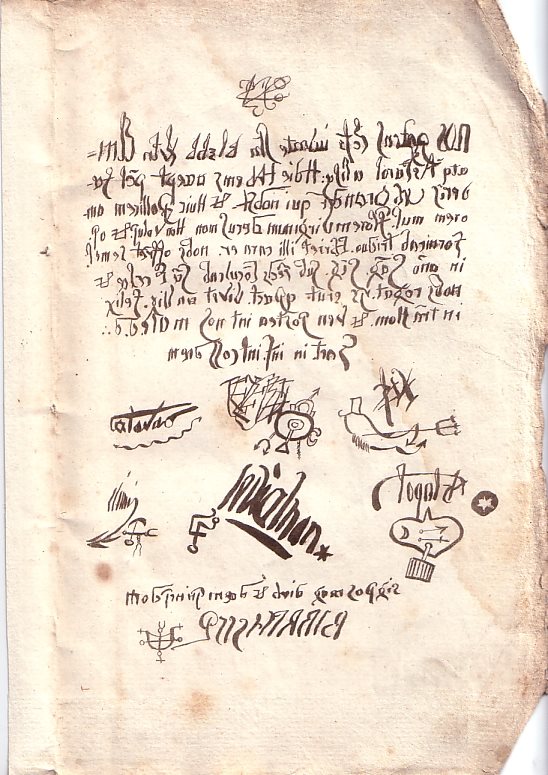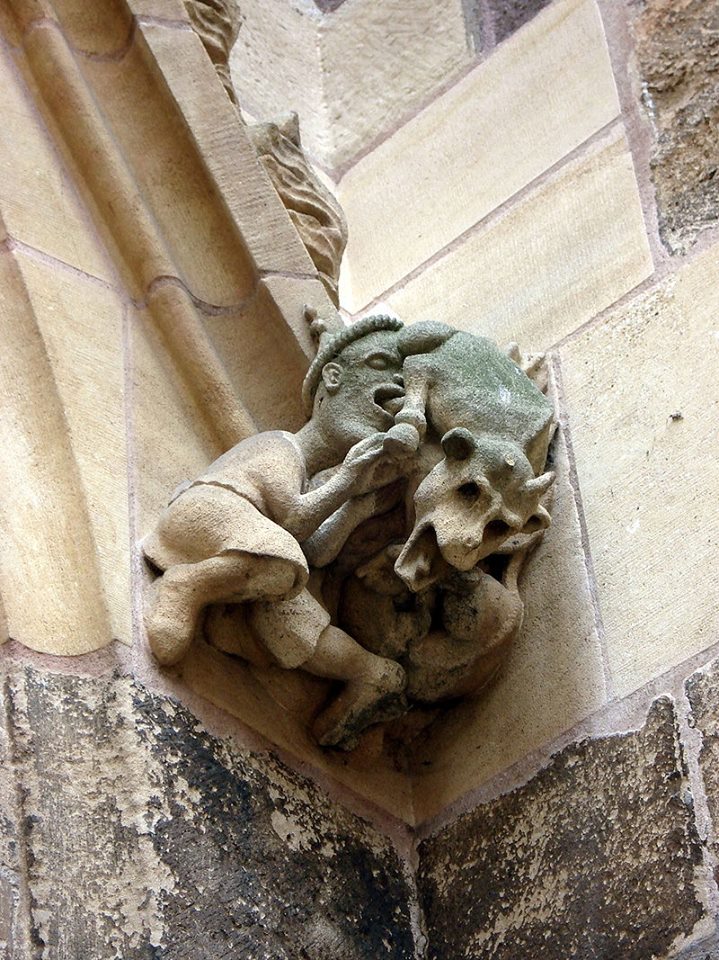
The pact by Urbain Grandier. Early 1600s. English translation is at the end of this lecture.

A “Judensau” (Jew-Pig) on the Cathedral of St. Martin in Colmar, France. This is a grotesque (or “gargoyle”) featuring a Jewish man apparently sucking on a devil; the association between Jews and demonolatry goes back to the early middle-ages in Europe, and is reflected in the Grimoires.
So far we have discussed Azazel as the original bearer of the title Satan; but moving ahead in time, we find more names: Leviathan, Lucifer, Belial. Of these, Belial appears as one of the 72 listed entities in the Ars Goetia.
There is no evidence that all 72 entities described in the Ars Goetia have an ancient counterpart. It very well may be that some came from historical entities, and the rest from elsewhere, perhaps invented or discovered by the sorcerers who wrote the grimoires. But it is interesting to note the great lengths that a religious tradition who prohibited having “gods before me,” literally meant having gods that existed before that god existed.
One such Canaanite god, Lotan, becomes Leviathan. But it the Old Testament, Leviathan is not associate necessarily with the adversary or with demons at all. Later on, in the middle ages, particularly in St. Aquinas’ writings, Leviathan became association with Satan: Leviathan is a worldly sea-monster who will swallow up unbelievers who do not accept salvation.
“In that day the Lord with his hard and great and strong sword will punish Leviathan the fleeing serpent,
Leviathan the twisting serpent,
and he will slay the dragon that is in the sea.” (Isaiah 27:1)
The Book of Isaiah is not the only book in which Leviathan surfaces. In the Old Testament, we find Leviathan mentioned in the Books of Job and Psalms, and in the apocryphal works the Book of Enoch, Book of Esdras. Isaiah, however, is also where we find Lucifer.
But If you go to the Creationist Museum in Kentucky you will be told that Leviathan was a Plesiosaur (because the only thing more unpalatable than evolution, to a fundamentalist, young earth creationist, is the existence of pre-Israelite religious traditions that influenced early Judaism). The inclusion of a sea-monster as a demon may seem somewhat strange, considering these civilizations clashed over a desert. But the concept of the mouth of a monster, or demon, or fallen angel, being associated with being entering the afterlife is not uncommon. More on this when we talk about Hell. From the Canaanite pantheon, we also find other sea monsters besides Lotan (Leviathan), including:
https://en.wikipedia.org/wiki/Tannin_(monster)
https://en.wikipedia.org/wiki/Rahab_(Egypt)
and many, many others. This is a class on Satan, not on pagan gods whom no one remembers, so I can’t go into everything.
So the theory is that the Israelites, who had a god named El, exterminated the Canaanites (as the otherwise historically inaccurate Book of Joshua commands them to).
The Canaanites happened to also have a god named El (remember, both these groups had a common ancestor and shared language).
So this god became Belial (beli- (בְּלִי “without-“) and ya’al ( יָעַל “value”)), and was also referred to by the title of Satan. Even if you don’t know Hebrew, you can kind of see there’s a pun to be made here, but I don’t want to go as far as make that claim.
In other words, it appears that the either (or both) the Canaanite-El became Belial, or Belial is a title given to another god, perhaps of the Babylonians or another group referred to as the Philistines. But earlier on in the Bible, in Leviticus particularly, Satan is identified with Azazel, an impersonal force that was worshipped against and feared. Much later, in the final section of the Old Testament, or Hebrew Bible, Belial becomes referenced, but Azazel basically vanishes.
Perhaps the title was changed over, or the impersonal adversarial force represented by Azazel became obsolete as the Canaanite-El served as a more real entity, and more worthy of the name Satan.
Whatever the case may be, by the time we get to the pre-modern era, where the grimoires were written, Belial is retained as a proper name for Satan, and Azazel has disappeared from the Judeo-Christian lineage. However, it is extremely noteworthy that in Islam and from what little we know about the Yezidi religion, Azazel is still a named entity. In Islam, Azazel is familiar — he is Shaytan, and the devil (iblis). In Yezidism, Azazel becomes the most favoured entity of the Yezidi god, the proper name of the first of seven angels who interact with the world; Azazel’s new title here is Melek Taus, meaning Peacock Angel, and he brings good things as well as inflicts punishment upon the Yezidis. Some claim that Yezidis are therefore “devil worshippers” but this is a wholly irresponsible and ignorant claim. The name Azazel has floated around the Levant long before any of these other religions had even started. If anything, the notion of Azazel as a two-faced rewarder-adversary captures a clearer theurgic notion than any competing story. But is Azazel satan? In the Yezidi system, clearly not.
Going back to Ars Goetia, we find a curious entry:
“The 68th spirit is called Belial, he is a mighty king and powerfull; he was Created next after Lucifer,” says the Ars Goetia, which preserves the notion that Satan and Lucifer are two distinct entities, Satan being an external enemy and Lucifer being an internal enemy (i.e. a rebellion or turning away from within a group).
“And what concord hath Christ with Belial? or what part hath he that believeth with an infidel?” 2 Corinthians 6:15 KJV
The Goetia is an incarnation of works that purport to be written by, about, or from the perspective of King Solomon (not the historical one, but an alternate version who was a sorcerer who bossed demons around). It is clearly the case that Solomon did not write any of this, as the grimoires appear starting in the 1600s and as late as the mid-1800s, in central Europe, in modern languages, and using variations of Biblical and Greek names that are not found elsewhere.
It is more than likely that the Biblical overtones of the grimoires, including the Ars Goetia et al’s veneer of “Solomonic Magic” was a blind that served a dual purpose — it was an alias these sorcerers used to escape scrutiny, and it was a way to make their workings look pious and holy instead of being legitimate attempts to conjure genies who would give them gold, naked women, knowledge of the universe, and unmitigated power. If they did not have these Biblical overtones, these books would certainly have been burned or at the very least, locked up in a vault never to be seen again. Another theory is that these works demonstrate a vein of European anti-semiticism prevalent at the time, in which Jews (King Solomon being one such) having some sort of magical, infernal connection with demons and Satan himself.
In the Rabbinical Old Testament, Belial is mentioned 27 times, in concordance with Satan, but not interchangeably with Lucifer (Book of Isaiah) or Azazel (Leviticus). In the Ars Goetia, Belial is Satan. And within the Ars Goetia, Lucifer existed before Satan. But in other places, you will find the three used interchangeably, or Lucifer becoming the entity Satan. And in the Zohar, medieval Jewish mysticism, Belial appears lower in the tree of Qliphoth than does Satan, so the two seem to syncretize in some places, and are broken apart in other places. What is the fact of the matter?
In Abramelin the Mage, an early 1600s grimoire, the entities involved include Lucifer, Satan, and Leviathan, Belial. But in the Ars Goetia (1700s), Lucifer is mentioned, but indirectly. Satan is assumed to be Belial in the Ars Goetia, but in Abramelin they are distinct.
In yet another grimoire, the Grimorium Verum, an almost entirely different group of demons than the Ars Goetia’s 72 are given. However, the three chief entities are now Lucifer (mentioned by name, but not a part of the Ars Goetia’s liste), Beelzebuth (compare to Bael in Ars Goetia), and Astaroth (same as in Ars Goetia).
In the Grimorium Verum, the three chiefs have direct subordinates:
Lucifer: Satanackia and Agalierap.
Beelzebuth: Tarchimache and Fleruty.
Astaroth: Sagatana and Nesbiros.
In both the Ars Goetia, and in one of the earlier grimoires, Pseudomonarchia Daemonum (1600s), which contains 69 entities, most of which appear amongst the Ars Goetia’s 72 entities, we find Nesbiros aka Naberius, who is basically the Greek three-headed dog Cerberus, who many of you know guards the Greek underworld, and is associated with both Hades and Hekate:
“Naberius [Naberus], alias Cerberus, is a valiant marquesse, shewing himselfe in the forme of a crowe, when he speaketh with a hoarse voice: he maketh a man amiable and cunning in all arts, and speciallie in rhetorike, he procureth the losse of prelacies and dignities: nineteene legions heare (and obeie) him.”
So it is clear that these texts influenced each other, or came from a shared magical traditional that was later on written down. But they come piece-meal from Greek and Hebrew sources, which in turn drew from earlier sources such as the Canaanites and Philistines (Babylonians). But this form of magical hyper-syncretization leaves no priveledged source. At the top, it appears that Lucifer, not Satan, holds office over everyone else — Ars Goetia claims that “[Belial] was created as the first, after Lucifer”
But also consider that in one of the later grimoires, the Grand Grimoire ( 1800s), Lucifer has no underlings listed. Furthmore, the same grimoire lists Satanackia as a commander who serves Satan. Amongst Satanackia are Pruflas, Aamon, Barbatos, and Astaroth. So if we put all of the Grimoires together, Satan (aka Belial) commands Satanackia, who commands Astaroth. And Lucifer just hangs out somewhere. Oh, and sometimes Belial isn’t Satan, who is named separately.
One way to deal with the overflow of entities, some of who are referred to by multiple titles, is to step away from looking at demonology as a unified and cohesive system, and instead inspect systems on their own. For example, the Ars Goetia, on its own, doesn’t contradict itself. But the notion of Belial as both Satan and not Satan, and Lucifer and Leviathan being around as well contradicts the hierarchy of demons laid out in the Ars Goetia as well as the historical narrative. This still may seem incoherent, but perhaps that is just the devil at work! Or, you know, the by-product of a bunch of people who wrote things in isolation based on incomplete information, differing political interests, and so on.
Lastly, consider this translation of a pact by Urbain Grandier, a French Catholic priest who was burnt at the stake for witchcraft on 18 August 1634. In English:
“We, the influential Lucifer, the young Satan, Beelzebub, Leviathan, Elimi, and Astaroth, together with others, have today accepted the covenant pact of Urbain Grandier, who is ours. And him do we promise the love of women, the flower of virgins, the respect of monarchs, honors, lusts and powers.
He will go whoring three days long; the carousal will be dear to him. He offers us once in the year a seal of blood, under the feet he will trample the holy things of the church and he will ask us many questions; with this pact he will live twenty years happy on the earth of men, and will later join us to sin against God.
Bound in hell, in the council of demons.
Lucifer Beelzebub Satan
Astaroth Leviathan Elimi
The seals placed the Devil, the master, and the demons, princes of the lord.
Baalberith, writer.”
The next lecture will continue on with the Grimoires, and how to analyze the techniques involved.
